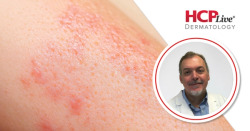
OR WAIT null SECS
Existing and Emerging Treatments for Actinic Keratosis
the high prevalence of the condition in middle-age and elderly populations has led to frequent updates on the long-term efficacy of current therapies and new investigational agents.
A new review on actinic keratosis detailed existing therapies to manage the skin disease including several new treatment option directed toward personalized treatment.
Actinic keratosis is a chronic skin disease that results in clinical and subclinical cutaneous lesions that coexist on sun-exposed areas of the body including the head and neck region.
Investigators led by Laura Del Regno, PhD, Department of Medical and Surgical Sciences at the Institute of Dermatology, University Hospital Foundation in Rome, noted the high prevalence of the condition in middle-age and elderly populations.
This has led to frequent updates on the long-term efficacy of current therapies and new investigational agents.
In their review, Regno and colleagues provided insights into therapeutic approaches for actinic keratosis while also illustrating the currently home-based and physician-managed treatments.
Home-Based Treatments
The most prevalent home-based topic treatments for actinic keratosis included imiquimod, 5-Flourouracil (FU), diclofenac, and tirbanibulin. All 4 of these treatments feature different mechanisms of action, different dosages and treatment durations, and requite adequate education to ensure therapeutic adherence.
Imiquimod, a toll-like receptor (TLR)-7 agonist, functions as a topical immune-response modifier that promotes the activation of the innate and adaptive immune response leading to the release of cytokines and chemokines.
The treatment also induces a direct apoptotic effect on tumor cells and is approved at 5%, 3.75%, and 2.5% concentrations for actinic keratosis located on the face or scalp of immunocompetent adult patients.
The pyrimidine analogue 5-FU is based on the inhibition of the enzyme thymidylate synthase. Various formulations including 5% ,1%, and 2% creams and solutions are available, as well as a 0.5% cream that can be applied once or twice daily in the area of lesions for 2-4 weeks for a maximum of 12 weeks.
Diclofenac is a nonsteroidal anti-inflammatory drug that blocks the enzyme cyclooxygenase 2, while tirbanibulin is a non-adenosine triphosphate competitive Src kinase agent inhibitor that blocks tubulin polymerization in actively dividing cells.
Regarding the latter treatment, a phase II study comparing once-daily application of 1% tirbanibulin ointment to actinic keratosis of the face and scalp over a 25 cm2 area for 3 or 5 consecutive days reported better outcomes with the 5-day treatment.
Ongoing Trials and Potential Treatments
A myriad of novel agents are under development with the intention of increasing the clearance rate and reducing local adverse events compared to current treatments.
Among these are resiquimod, a topical immune-response modifier that promotes the activation of myeloid dendritic cells and plasmacytoid dendritic cells through a direct mechanism on both TLR7 and TLR8.
The drug potentially achieves a higher potency (10–100 times) than imiquimod for the treatment of AK, with a higher production of interleukin-12 and tumor necrosis factor, based on its pharmacodynamic profile.
A total of 4 different concentrations (0.01%, 0.03%, 0.06%, and 0.1%) of resiquimod gel were investigated in a phase II study with a dosing regimen of 3 times per week for 4 weeks in 1 or 2 treatment cycles, with high efficacy rates being reported in all study groups.
Potassium dobesilate is an endothelial stabilizing agent that acts on the inhibition of vascular endothelial growth factor and fibroblast growth factor. However, the results of a phase II clinical trial evaluating efficacy and safety that was completed in 2018 were never released, and it is unclear whether this drug is still under development for actinic keratosis.
The non-steroidal anti-inflammatory drug celecoxib was tested in an intervention trial in 2019. Different concentrations of the topical formulation were applied once or twice daily, with the main outcomes assessed after 16 weeks. So far, no results have been provided.
“A number of features can affect the choice of AK treatment,” the team wrote. “When deciding a specific therapeutic approach, it is important to consider a variety of factors, including treatment duration, cosmetic outcome, patient compliance, local adverse reactions, treatment cost, and risk factors for recurrence.”
The study, "A Review of Existing Therapies for Actinic Keratosis: Current Status and Future Directions," was published online in the American Journal of Clinical Dermatology.


